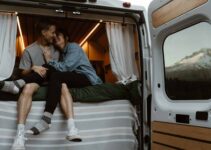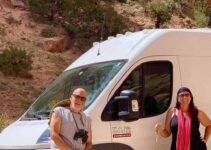Bobby and Mary are a couple in their mid-twenties who have adopted van life as a way to have great adventures while being able to work and complete coursework on the road. With their two dogs Ollie and Maya, Bobby and Mary left Idaho Springs, Colorado in the fall of 2021 with the goal of “living nowhere.”
Having never touched a power tool before, they completely built out their Ford E-350 cargo van with an extended base and high fiberglass roof.
Before hitting the road, Bobby was a salesman, raft guide, and training to be self-proclaimed “Mr. Colorado” while Mary was building her sustainable graphic design business. They lived out of a small, one-bedroom apartment in the mountains where their “backyard” was a meadow they would hike to every day.
Nearly every weekend in the summer in Colorado they would run off with their tent to forest service land all over the state. Along the way, they fell in love with living in the wild.
Then Bobby started saying “I want to live nowhere.” They didn’t know what that meant at the time but it was a feeling, a call to live a different kind of life. They say that they kind of accidentally stumbled upon Van Life.
The feeling grew into an idea when they ran into a fellow backpacker at Rocky Mountain National Park. Small talk at the permit office led to him telling them that he lived “nowhere” (he had a permit at the Grand Canyon next month and he’d see where next from there).
“#VanLife is really about is new places, experiences, and people. It’s gritty, it’s hard, and rugged, but beautiful.”
At first, they wanted to live out of their packs like him. Then they considered living out of their Prius. But after a few camping trips with their now full-grown pup, the space proved to be just not enough.
While searching for other options, they found a whole community of people building out and living in vans. And they decided to become one of them.
FIND THEM ONLINE!
The Van Setup
Bobby and Mary have a Ford E-350 cargo van with an extended base and high fiberglass roof, which came already installed when they bought the van. They choose it for one reason: any mechanic in any small town they may find themselves in will know how to work on it.
They were first set on a ProMaster. But, after doing extensive research on the best vans for van life, they found loads of reviews mentioning how difficult they were to maintain. Not being mechanically inclined, they decided to go with the Ford.
The Van At A Glance
| Van | Ford E-350 cargo van with an extended base and high fiberglass roof |
| Van Cost | $13,000 |
| Van Build Cost | $17,000 |
| Unique Features | With no experience working with power tools, they found inspiration from others and pieced them together for what works best for their lifestyle and rig. |
| Bed Setup | Partially fixed and partially slidable bed frame to accommodate a queen-size mattress. |
| Bathroom Setup | Natures Head composting toilet |
| Shower Setup | Outdoor solar shower bag |
| Kitchen Setup | Two kitchenettes with plenty of counter space, a Coleman camping stove and a square bar sink with a 12V electric pump that drains into a 6-gallon gray water tank below |
| Refrigeration | ARB chest fridge/freezer mounted on a drawer that slides out for access |
| Cooling | 2 Fan-Tastic Fans (one over bed and one over the kitchen area) |
| Heating | Mr. Heater propane heater |
| Power & Solar Setup | All Renogy setup including 170 Ah lithium battery, 400W solar with 2000W inverter. Installed 12-volt outlets and USB ports around various spots and a 110V power strip connected to the inverter |
| Water & Plumbing Setup | 40-gallon freshwater tank with a 12V electric pump filtered through a 3-canister system before reaching the faucet. The greywater drains into a 6-gallon portable tank that is emptied manually |
| Propane System | Portable 20-lb propane tank with a line that runs to the kitchen for the stove |
Bobby and Mary bought their van used for $13,000, after terrible haggling by Bobby. They upgraded the suspension, installed new all-terrain tires, and added a roof rack, solar panels and a swivel arm box with a bike rack on the back of the van.
They love everything about their van. But their favorite thing is their ability to bring the comforts of home everywhere they go. It feels like home to Bobby and Mary. They love that they can come down after summiting a peak at sunrise to a comfortable place to sleep and make food right away.

For the van bed setup, Bobby and Mary installed a partially fixed and partially slidable bed frame. About 2/3 of the bed frame is fixed and always up in the van with garage storage underneath. The final 1/3 slides in and out to form a queen-sized bed!
As sleep is a priority for outdoor enthusiasts who know how important a good night’s sleep is to waking early for adventure and recovering afterward, the bed setup was a priority for them.
In the bathroom, Bobby and Mary have a Nature’s Head composting toilet. It lives inside a wooden box with a lid. When closed, the box doubles as a seat and dog bed for Maya.
When it comes to showering, they only have a solar shower bag that they can set up outside. But they only use it at remote campsites. Otherwise, they find rec centers or campgrounds with showers about once a week.
Related: Check out our post to find out the best ways to find free showers while you are on the road!
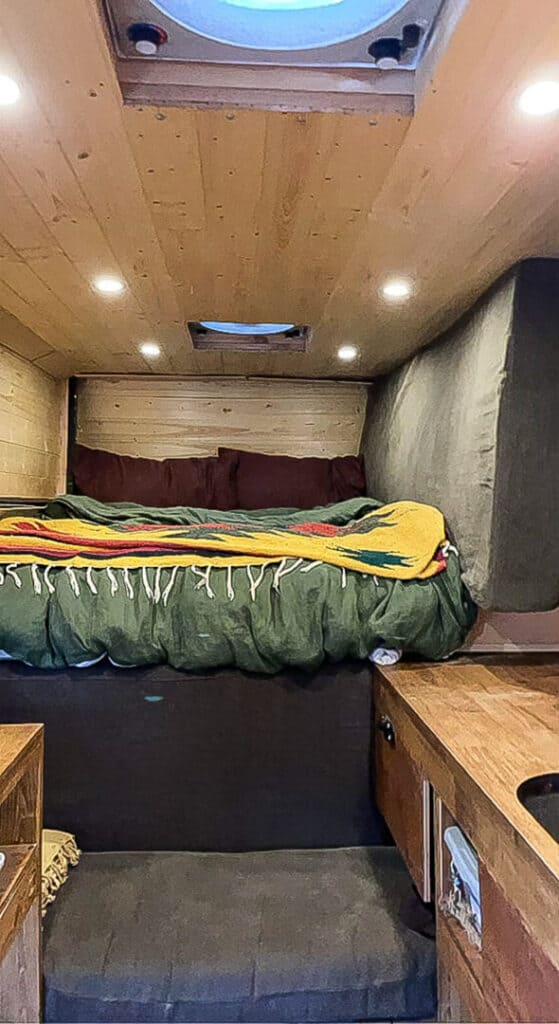
The campervan kitchen setup includes a stove, sink, gray water, cabinets, and two kitchenettes with plenty of counter space that can serve multiple purposes. They use a Coleman 2-burner stove that lives on the shelf of one of the two kitchenettes.
The sink is a simple square bar sink with an electric pump that drains into a 6-gallon gray water tank below. It has a faucet with a detachable hose and pumps for hand and dish soap. And there are cabinets to store cooking utensils and a spice rack fixed to the wall above the sink.
For refrigeration, Bobby and Mary use an ARB chest fridge/freezer that is installed below one of the countertops, sitting on a drawer that can be slid out when needed. The name is deceiving though. The quality ARB product does not have both a fridge and a freezer but instead can work as either a fridge or a freezer.
They just use it as a fridge though, so no ice cream after a day of hiking or paddling! Bobby and Mary went with the fridge/freezer vs the ARB option that had both purely because the size specs are what fits best with their setup.
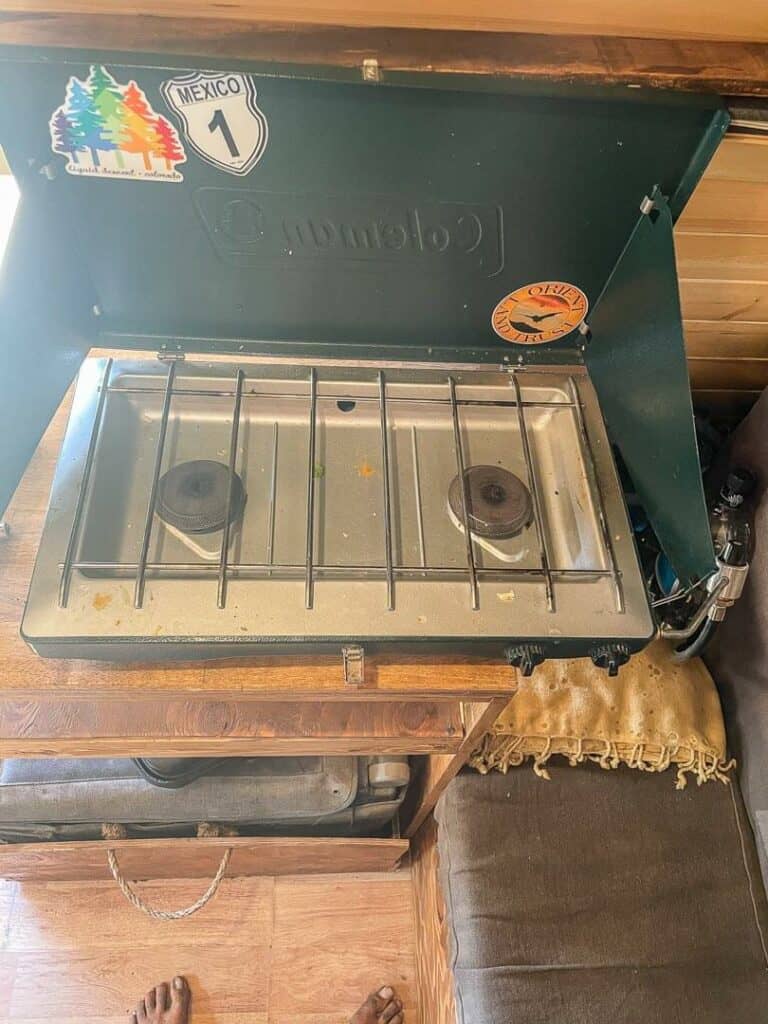
To set up inside, they simply pull it out onto the counter and hook it up to a hose connected to the portable 20 lb. propane tank in the back of the van. For outside, they have a table they set the stove on and they move the propane tank to it in order to connect.
When it comes to keeping cool, the van has two Fan-Tastic Fans leftover from the partial build from the person they bought the van from. One fan is above the bed and the other is located in the kitchen area. Running both fans, one on in and one on out creates some great airflow. They creatively call it “Fanology.”
Also, the space by the fan in the kitchen is slightly taller than the rest so it allows Bobby to stand up completely straight while cooking, doing the dishes, or just standing there munching on food.
To keep warm, Bobby and Mary rely mostly on body heat and some great sleeping bags! Two people and two dogs are often all they need. But they do have a stand-alone Mr. Heater that they only use on really cold nights.
The van’s campervan’s propane system is entirely portable. It has a 20 lb. propane tank that is stored in a sealed box in the garage area. There is a hole drilled in the bottom so that, in the case of a leak, it drains to the outside.
Bobby and Mary then have an 8ft hose to connect the tank to their camp stove. Aside from occasional Mr. Heater use, the only other propane appliance in the van is the portable Coleman camp stove.
For a water system in the van, it is equipped with a 40-gallon freshwater tank with a 12V electric pump that filters through a 3-canister system before reaching the sink faucet. Wastewater from the sink drains into a 6-gallon gray water tank that Bobby and Mary empty manually. Because the van has a composting toilet they do not have black water.
When it comes to power, Bobby and Mary equipped the van’s power system adequately to support their need to work on the road. They bought a kit and all their components from Renogy as a kit was the easiest on a time crunch. The power setup includes one 170 amp-hour lithium battery, 400 watts of solar and a 2000W inverter.
They have also installed 12v outlets and USB ports around various spots in the van. And there is also a power strip that runs from the inverter for anything that requires 110 volts.
Because Mary works on the road and Bobby takes online classes, their office setup is critical. They have dedicated indoor and outdoor bamboo tables that fold up pretty small.
The indoor Beckworth table fits perfectly in the cab with both seats swiveled to the inside. Then their KingCamp outdoor table is much bigger and for work, Mary has a chair made for sitting in hunting blinds that has great lumbar support but also folds easily to fit in the garage.
When it comes to where to eat a meal, Bobby and Mary always switch between one of the tables or simply sit in the various indoor and outdoor seating options they have and eat less formally.
Bobby and Mary only have one thing each they wish they could have had in their van. For Mary, it would be a 4-wheel drive conversion. For Bobby, it would be an extra few inches of space in each direction.
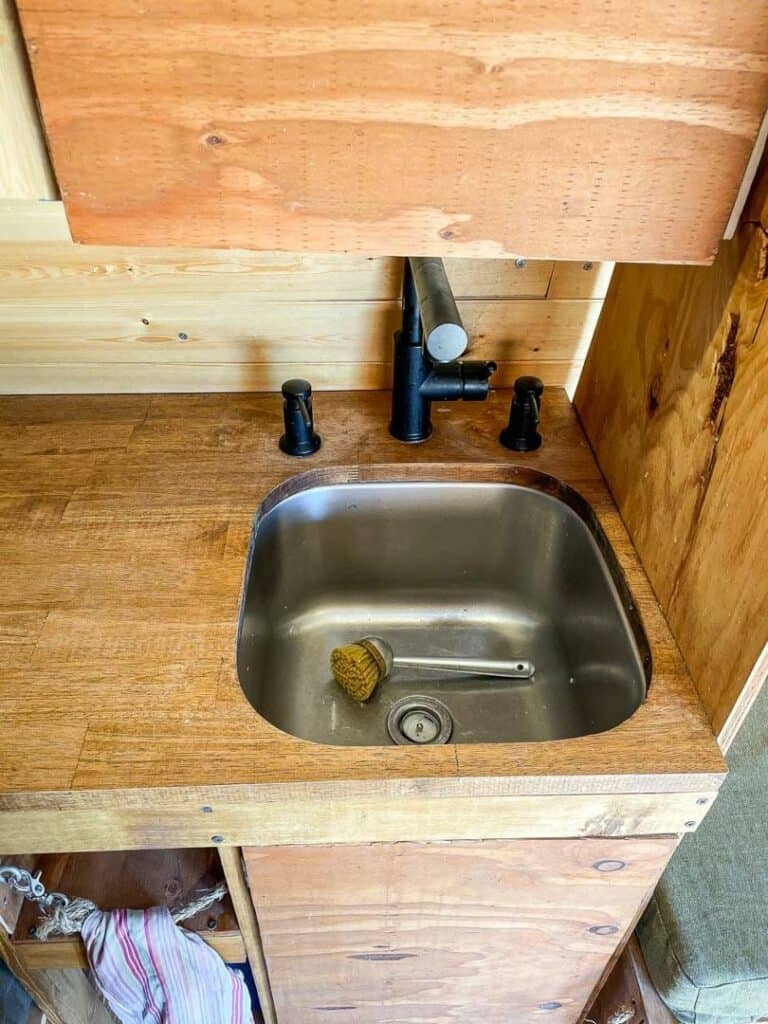
READ MORE: Check out this post on other great vans for camper conversion.
Living the #VanLife Lifestyle
As for the #VanLife lifestyle, Bobby and Mary agree that it is about a lot more than what you’ll see when you search on social media. What you’ll see is romanticized views, a seemingly easy lifestyle and lots of exciting new places.
And while #VanLife has all of those things, what it’s really about is new places, experiences, and people. It’s gritty, hard and rugged, but beautiful.
Part of the van lifestyle for Bobby and Mary includes staying connected for work on the road. Mary has built her branding business so that she only does client work Wed-Fri, having the other days to explore and live the van lifestyle. This earns them enough to live for the most part, especially if they live frugally.
But, before they hit the road and while they both worked full time, they also did the “beans and rice diet” for many months to build their savings.
Read Next: Stay connected on the road with everything you learn in this post about van life internet!
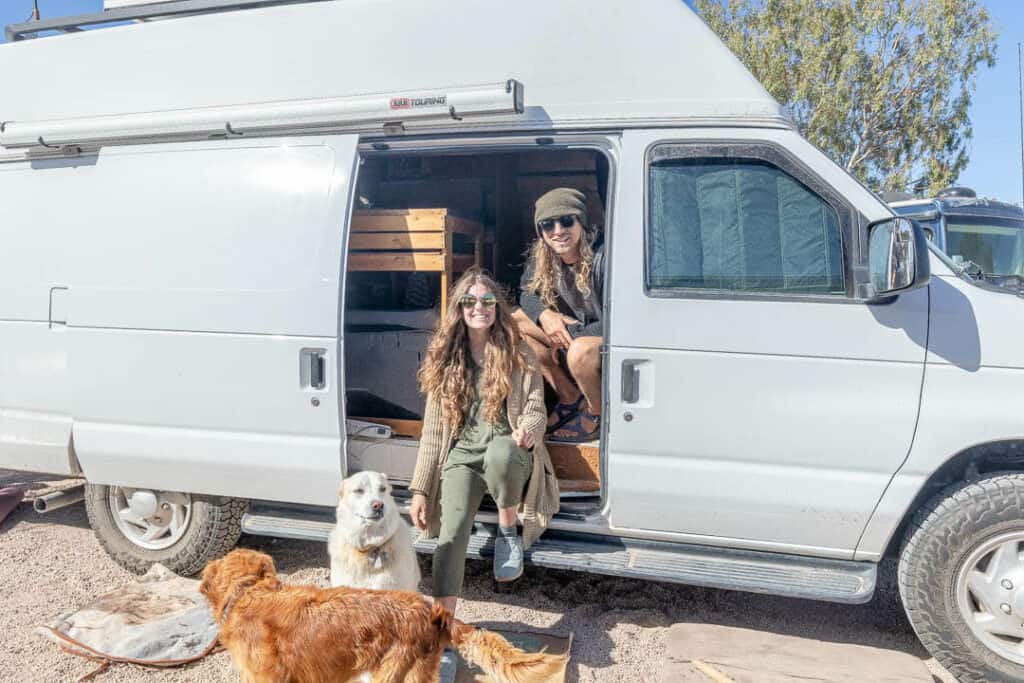
Hands down the thing that has surprised them the most is the people they meet along the way. Almost everyone they’ve met on the road has been the kindest person who wants nothing more than to help and/or connect with another person. It really is a community.
The growth you experience from putting yourself in sometimes uncomfortable situations always turns out exactly as it should. Bobby and Mary have only been on the road for half a year, but already they feel like they are different people than when they started, in a really beautiful way.
But there are challenges to #VanLife. So many challenges! Van life is full of hardships from things breaking, not going as planned or just living in the elements/constantly on the move. It’s part of what makes this life so great! Something hard happens and you don’t have the time to freak out, you just overcome.
Yet being away from family and friends has been the hardest for Bobby and Mary, especially around the holidays.
As for how much #VanLife costs Bobby and Mary, they fall back on a story of a man they recently met who told them an interesting saying: “Money has an interesting quality, where the next dollar you earn is always worth less than the dollars before it.”
“Something hard happens and you don’t have the time to freak out, you just overcome.”
They are fortunate to be able to earn an income on the road through their business to make life on the road more sustainable. With all that being said, Bobby and Mary have not been keeping a strict budget since they left.
Related: Check out our post on all the awesome ways you can make money on the road!
But they estimate that they are living probably somewhere between $2,500 and $3,000 a month. Insurance is one of the biggest expenses and between health/car insurance they pay about $650 a month.
Downsizing was simple for Bobby and Mary. As backpackers and sustainability nuts, they have been trying to live on as little as possible for years. They even paired down their kitchen utensils to just what would fit in their van about a year before they hit the road so they would be prepared even for the little adjustments. And they also lived in a small apartment beforehand so they were used to tight spaces.
Bobby and Mary both miss where they used to live in Clear Creek County, Colorado. The trails, town and people have such a special place in their hearts and it was hard to leave.
For fun on the road, Bobby and Mary love to get out and explore. They try to stick to dog-friendly activities. But luckily Maya and Oliver are solid trail dogs so they spend most of their free time hiking or mountain biking.
Currently, they are in Baja, Mexico and have been learning to surf. Maya loves chasing birds on the beach and Ollie likes to hang out and “guard” their stuff. They love learning and the topic of sustainability, so once they are tired from a day on the trail or a long day of grinding on the computer, they like to discuss new ideas and watch documentaries.
The takeaway about #VanLife that both Bobby and Mary want people to understand is that this life is not necessarily for everyone. It’s easy to fall into the romance of what the lifestyle can give you.
But it’s more than pretty views. It’s about growth and personal development as much as it is about exploring. They jokingly call their van “Dirtbag Manor.” To a dirtbag, they’re living really nice. But it’s still rugged and definitely not easy.
Van Life With Dogs
Bobby and Mary are among many van dwellers who find that life on the road is best shared with the company of their two dogs, Ollie and Maya. They love their dogs more than anything so being able to share this adventure with them is such a big reward.
The dogs make everything more fun and also help them to feel safe. Life on the road with dogs also comes with the challenges of border crossings, pet food in different countries, barking in campgrounds, interactions with people who don’t like dogs, etc. But it’s all worth it.
Top Mobile Apps
iOverlander and Campendium are the two biggest apps they use. Bobby loves looking at the map and planning their next adventure.
Before they left, he scouted areas using these apps and put things like hiking trails, campsites (color coordinated by cell service), hot springs and bike trails on a Google MyMap.
He’s always adding to it so they don’t have to plan an itinerary. But when they arrive to a new area, they can just check the map and have lots of options that they know are right for them.
READ MORE: Learn more about 20+ van mobile apps that you must have for van life!
Most useful items:
1. ARB Fridge/Freezer. They have spent many trips changing out ice in standard coolers before van life and one memorable food poisoning experience. Having the fridge is huge.
2. WeBoost cell phone signal booster. Their booster consistently gives them 2-3 more bars and allows us to do zoom calls and work with large files even in more remote locations.
3. Verizon Jetpack Mobile Hotspot. For the same reasons as the WeBoost. Their hotspot works great and Verizon (at least at the time this was written) has seemed to have the best coverage for digital nomads.
4. RV Water Filter Store’s Triple Canister System. Their water tastes great no matter where they get it from. And in a pinch, they can even filter the water from a river/creek in Mexico.
5. Nature’s Head composting toilet. Being self-contained is extremely useful.
READ MORE: Read this post to learn more about other great van life essentials.
The Van Build
The entire van build cost around $17,000, which includes the add-ons to the van like shocks and tires as well as work that they hired out. Bobby and Mary claim that the build could have been done for a lot cheaper but they were pressed on time at the end and they also built during the height of the peak lumber prices in 2021, where lumber prices were double what they normally are.
For the most part, Bobby and Mary built the van themselves. They did hire some help for a few projects that they became too scared to do themselves.
The main one they hired help for was building the electrical and power system. Bobby had drawn up the plans but got cold feet and found an awesome van builder who did the electrical for a fair price. But they also paid for help with the roof rack, shocks, swing arm box and bike rack.
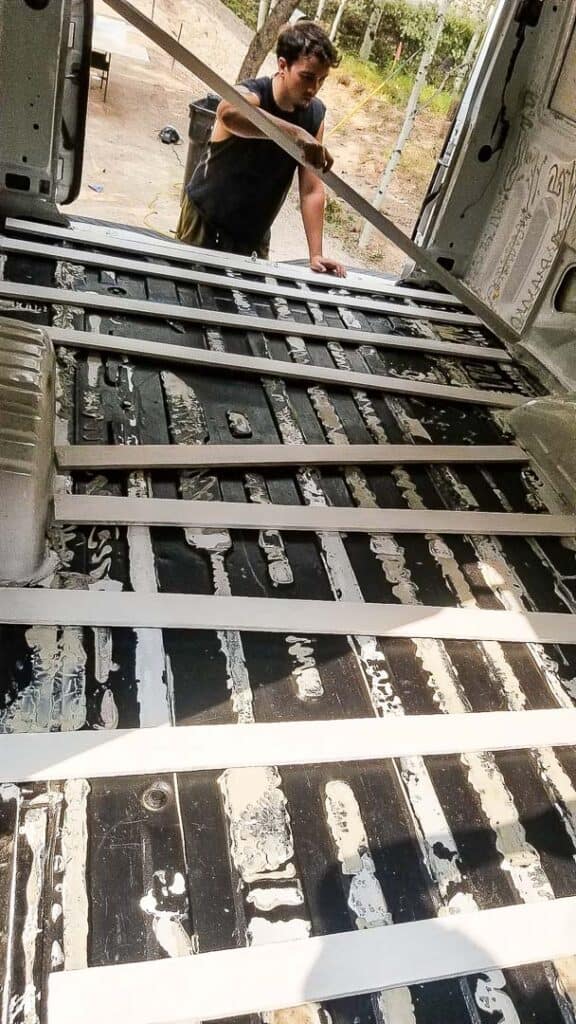
With no mechanical experience, upgrading the shocks themselves was not going to happen. Additionally, they have a fiberglass high-top roof and did not want to mount the solar directly to it so they needed a custom roof rack built.
Around 2 years before they even purchased their van, they scoured the web for tons of information. Most of what they did was piecemealed together from a lot of random information. But the van-dwellers subreddit and Gnomadhome were the two resources that they found the most helpful.
Bobby and Mary are most proud of the whole interior. They had never even used a power tool before they started so seeing it all come together and look as nice as it does was something for which they are really proud. When starting, it was hard to imagine being able to build everything that they did.
The van build even included its own custom-designed cabinets. All of these were designed on the fly once they figured out the exact spaces available for them. They knew the measurements of some of the things they wanted to store, so that helped for guiding the size. Most of the cabinets are held closed with hooks and eyes but some have latches. And the cabinet with Mary’s work stuff has an actual lock on it.
For insulation, Mary and Bobby used sheep wool. With sustainability and their health in mind, sheep’s wool seemed like the best fit. Putting in the sheep’s wool was tedious but also felt like they were wrapping the van in a warm wool sweater.
They got loose-fill insulation that was stuffed in all the ribs of the van. And then they used batts of insulation to cover the wall between the studs and under the paneling.
Related: Read our post on why planning your campervan ventilation is so important.
As for windows and lighting, they did not add any additional windows to the van. As they have a cargo van, the only windows are the front two, the windshield and the back two.
The back two windows are below the bed and stay covered 100% of the time. The van also has LED puck lights because of their low electrical usage and Bobby and Mary liked the aesthetic of the puck vs strip lights.
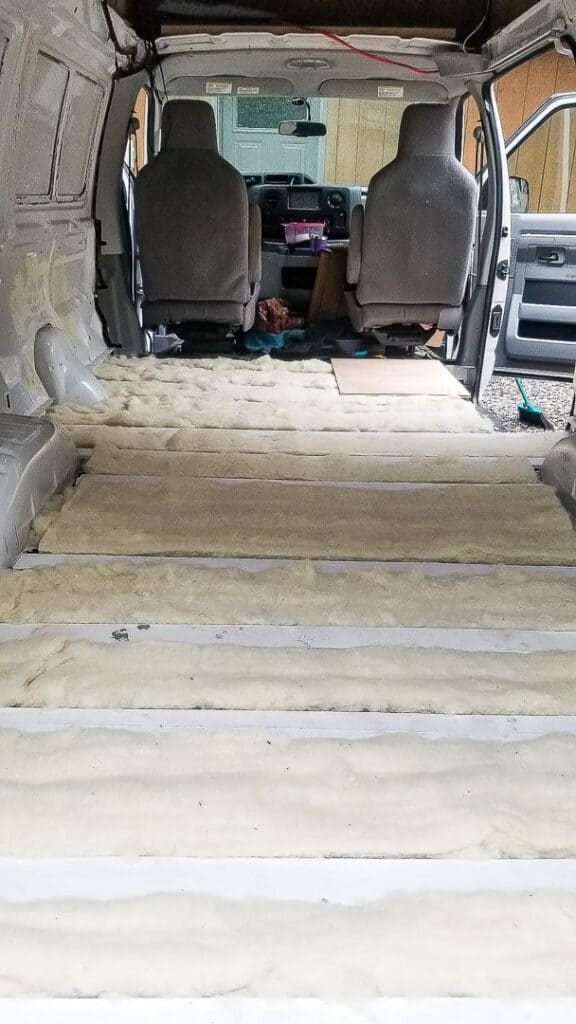
For flooring, Bobby and Mary are not entirely sure what kind of floor they installed! The van had the flooring in it when they bought it. But they ripped it out to put in a proper subfloor. Then they reinstalled the wood-looking flooring to reduce waste.
In the garage area under the bed, they used a recycled rubber gym flooring material because the rubber is durable and waterproof. The garage sees a lot of use with dirty gear and boots.
And the ceiling is completed with the same pine tongue and groove paneling that was used for the walls. And it is quite thin so they did not lose too much headroom and love the cabin feel it provides.
For storage, it was important to make it modular. Where you think you’ll store things vs where you end up storing things are often different. So having that flexibility to move things around is helpful.
The van has a spacious garage located under the fixed section of the bed. It is about 38 inches tall so provides a ton of space for storage. Most of Bobby and Mary’s stuff is stored in bins.
They also have some rubber clips screwed into the garage area that allow them to hang things securely, such as bike helmets and hiking bags.
Related: Check out our best storage and organization tips for van life!
As for a 110V shore power connection, the van does not have one. Bobby and Mary always wild camped before they built the van so they planned their whole build around being able to camp off-grid and be self-contained. With a robust solar system, they do not want for power.
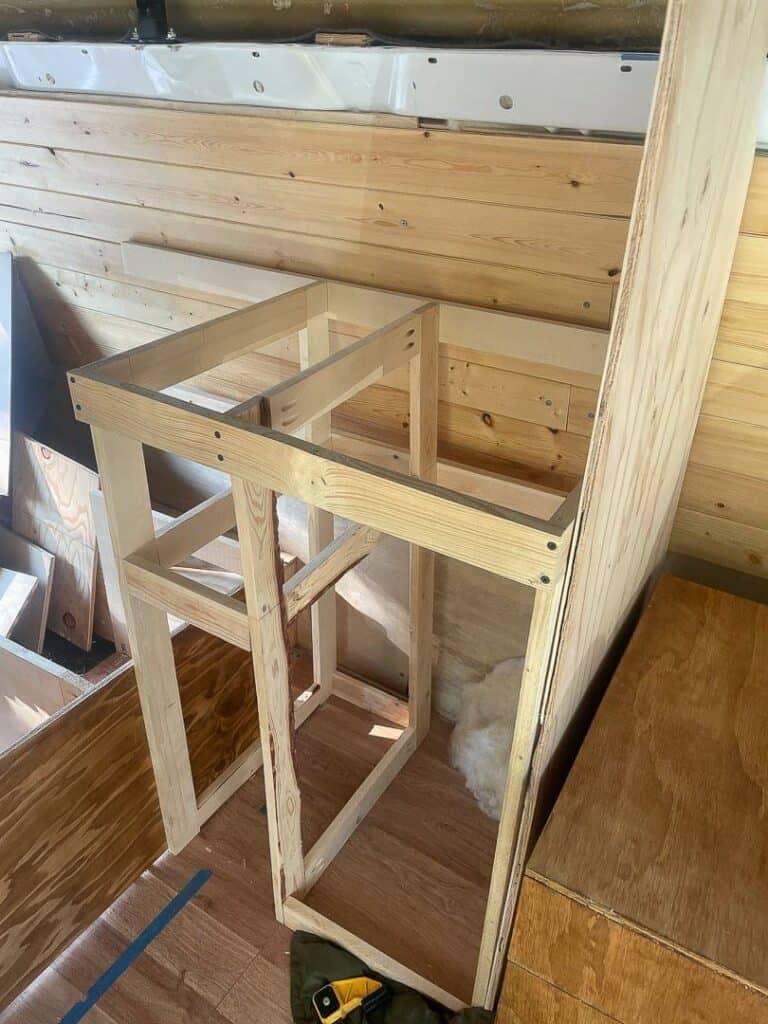
The weak point in the van’s design is the swing arm storage box on the back of the van. Bobby and Mary were convinced to go the cheaper route and not buy the name brand. Now, they have had lots of issues with it breaking so that it doesn’t work like it should, making it difficult to open and get to the garage.
The hardest part of the build was actually getting started. As neither Bobby nor Mary had ever built anything before, once they had their plans set they always found reasons to push it back another week because they were nervous to make mistakes.
They eventually had to say “screw it” and just go for it. In the end, they only wasted a small amount of wood and materials on mistakes. So in hindsight, they wish they would have gotten over the fear of building sooner. With all that being said, they are not entirely convinced that one specific part of the building was harder than another because each task was so different that they all felt extremely daunting and challenging.
When it comes to modifications since hitting the road, Bobby and Mary have only made small additions such as more rope to hold things secure. But, for the most part, the build was completely finished before we left.
And the only thing that has really failed them in the build has been the outside swing arm box. They put a ton of thought and planning into the setup and almost everything has worked just as they hoped it would.
Related: Start your van conversion planning with our ultimate DIY van build guide!
As for advice Bobby and Mary would give you before you set off to complete your campervan build, they say “Send it!!” If traveling the world by car is something you are interested in doing, they would say do some solid research and make sure you get a solid van that fits all of the things you are hoping for.
They almost jumped the gun and bought a van with a low roof because they were being impatient with the build. But they have learned that in being around 6 feet tall they would have been miserable without the high-top roof.
So just make sure you really understand the space you have and your priorities before you buy a van and start building. Their priorities were (1) Sleep (2) Work (3) Exploring so it was easy to make the decision to include a queen bed with lots of garage storage space and a great work setup and not include things like a shower.
To learn more about their van and adventures of full-time van life on the road be sure to check them out on their Instagram account!
This post may contain affiliate links. That means if you make a purchase a product we recommend using the links in this article, we may receive a small commission at no extra cost to you. We promise to use this pocket money to buy lots of coffee and fuel for the campervan to keep us enjoying #VanLife for just a little longer. We appreciate your support, and only recommend products we know and trust. Thank you friends!
